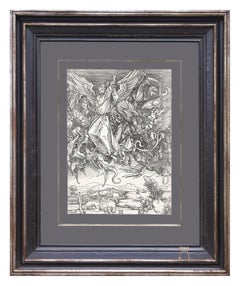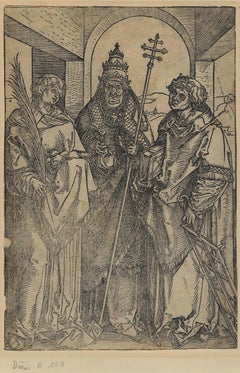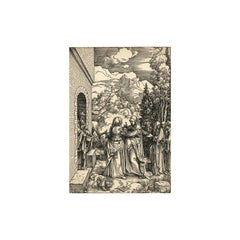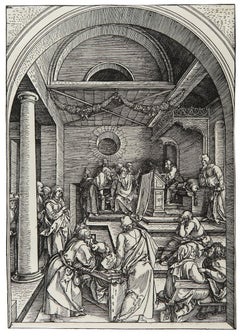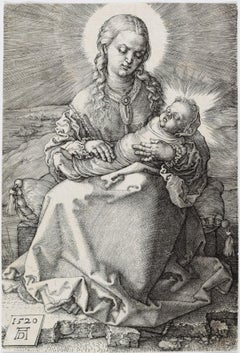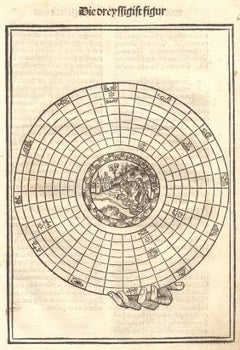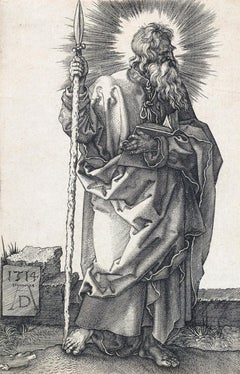18th Century and Earlier Art
to
4
4
3
7
6
1
Overall Height
to
Overall Width
to
5
7
6
6
2
1
1
1
8
14
166
128
95
92
4
4
1
1
Period: 18th Century and Earlier
Artist: Albrecht Dürer
Saint Michael fighting the Dragon
Located in Zürich, CH
"Saint Michael Fighting the Dragon (B. 72; M., Holl. 174)"
This engraving is a print from the Latin publication of the text of the Apocalypse of 1511. Dürer’s series dedicated to the Apocalypse comprises 15 engravings and a title sheet. The master worked on this series from 1496 to 1498. In 1511, Dürer repeated his Latin edition and provided it with a prohibition on the series being copied. The Apocalypse was intended for extremely varied levels of society. All of the sheets are united by the theme of the battle between good and evil.
The work refers to a quote from the Revelation of St. John the Divine: “And there was war in heaven...
Category
18th Century and Earlier Art
Materials
Engraving
Samson Killing the Lion
Located in Zürich, CH
The woodcut is listed as Bartsch: 2, Medes: 107d.
Upon returning from his 1495 trip to Italy, Albrecht Dürer produced large woodcuts of unprecedented complexity culminating in his S...
Category
18th Century and Earlier Art
Materials
Woodcut
Saints Stephen, Sixtus, and Laurentius
Located in Middletown, NY
circa 1504
Woodcut on cream laid paper, 8 1/2 x 5 7/8 inches (215 x 148 mm), thread margins. Significant expert repairs to lower right sheet edge, and center right sheet edge. Mino...
Category
Old Masters 18th Century and Earlier Art
Materials
Laid Paper, Woodcut
Die Heimsuchung (from Marienleben)
Located in London, GB
This is one of twenty woodcuts that together comprise The Life of the Virgin, a series on which Dürer worked for some ten years. Seventeen of these woodcuts were finished when the artist left for Italy in 1505. (There they were copied as engravings by Marcantonio Raimondi—much to Dürer’s chagrin.) Dürer finished the last two woodcuts as well as the frontispiece only in 1510. The set was then published in 1511 together with The Large Passion, accompanied by Latin verses written by the Benedictine monk Benedictus Cheledonius. On this occasion Dürer also reissued his Apocalypse series in order to offer his Große Bücher (Great Books...
Category
18th Century and Earlier Art
Materials
Woodcut
Der zwoelfjaehrige Jesus im Tempel - Christ among the doctors
Located in London, GB
This is one of twenty woodcuts that together comprise The Life of the Virgin, a series on which Dürer worked for some ten years. Seventeen of these woodcuts were finished when the artist left for Italy in 1505. (There they were copied as engravings by Marcantonio Raimondi—much to Dürer’s chagrin.) Dürer finished the last two woodcuts as well as the frontispiece only in 1510. The set was then published in 1511 together with The Large Passion, accompanied by Latin verses written by the Benedictine monk Benedictus Cheledonius. On this occasion Dürer also reissued his Apocalypse series in order to offer his Große Bücher (Great Books...
Category
Old Masters 18th Century and Earlier Art
Materials
Woodcut
Madonna with a Swaddled Infant
Located in San Francisco, CA
Original engraving printed in black ink on laid paper.
Dated and signed with the artist’s monogram on a tablet lower left.
A superb, richly inked 16th century/lifetime Meder “a” (o...
Category
Old Masters 18th Century and Earlier Art
Materials
Engraving
The Virgin and Child with Saint Anne, ca. 1500
Located in New York, NY
Albrecht Dürer (1471 – Nuremberg – 1528), The Virgin and Child with Saint Anne ca. 1500, engraving; 115 x 71 mm (4 ½ x 2 13/16 inches), B...
Category
Old Masters 18th Century and Earlier Art
Materials
Engraving
Madonna and Child with the Monkey
Located in San Francisco, CA
A good, clear later 16th century Meder “l” impression, showing strong contrasts throughout, printed after the appearance of the dot in the clouds upper center.
Catalog: Bartsch 42;...
Category
Old Masters 18th Century and Earlier Art
Materials
Engraving
Related Items
Double
Located in Santa Fe, NM
Edition of 7
Category
Surrealist 18th Century and Earlier Art
Materials
Woodcut
Father Stefan Fridolin, "Schatzbehalter" (Treasury of the True Riches
Located in Fairlawn, OH
Father Stefan Fridolin, "Schatzbehalter" (Treasury of the True Riches of Salvation): The 30th Figure - Astrological Diagram with Scene of the Nativity
Woodcut, 1491
Unsigned, as issued
Published by Anton Koberger
Diagram has Zodiac signs on outer ring, planets in the lower registers, and Nativity in the center.
Condition: Very good for a 15h century woodcut, with the usual slight age stains
Sheet size: 11 1/2 x 8 1/4 inches
Wogelmut was the teacher of Albrecht Durer and employed young Durer in many project of the last decade of the 15th century.
Michel Wolgemut Biography
Wolgemut trained with his father Valentin Wolgemut (who died in 1469 or 1470) and is thought to have been an assistant to Hans Pleydenwurff in Nuremberg. He worked with Gabriel Malesskircher in Munich early in 1471, leaving the city after unsuccessfully suing Malesskircher's daughter for breach of contract, claiming she had broken off their engagement. He then returned to his late father's workshop in Nuremberg, which his mother had maintained since Valentin's death.
In 1472 he married Pleydenwurff's widow and took over his workshop;[3] her son Wilhelm Pleydenwurff worked as an assistant, and from 1491 a partner, to Wolgemut. Some consider Wilhelm a finer artist than Wolgemut, however he died in January 1494, when he was probably still in his thirties. Wilhelm's oeuvre remains unclear, though works in various media have been attributed to him.
Woodcuts
Michael Wolgemut, Danse Macabre, 1493
Two large and copiously illustrated books have woodcuts supplied by Wolgemut and his stepson Wilhelm Pleydenwurff; both were printed and published by Germany's largest publisher, the Nuremberger Anton Koberger, who was also Dürer's godfather. The first is the Schatzbehalter der wahren Reichthumer des Heils (1491); the other is the Historia mundi, by Schedel (1493), usually known as the Nuremberg Chronicle...
Category
Old Masters 18th Century and Earlier Art
Materials
Woodcut
"Nohubo remedio" (There was no remedy) - Etching and Aquatint on Paper
Located in Soquel, CA
"Nohubo remedio" (There was no remedy) - Etching and Aquatint on Paper
Bold 3rd or 4th edition, circa 1868-1878, with burnished aquatints, drypoints etching, and engravings by Franc...
Category
Old Masters 18th Century and Earlier Art
Materials
Engraving, Paper, Etching, Aquatint
H 22.5 in W 20.5 in D 1.5 in
BATHOS / Tail PIece
Located in Santa Monica, CA
WILLIAM HOGRATH (1767- 1764)
THE BATHOS / Tail Piece 1764 (Paulson 1989: 216 I/I Paulson 1965/70: 216 I/I)
Engraving Plate 12 7/8 x 13 3/8, sheet 17 ¾ x 18 ¾ Designed & Engrav’d by Wm Hogarth at left and Published according to Act of Parliam’t March 3, 1764 at right. Good condition on thick laid paper Small bit of tape on the left & right sheet edges small stan lower sheet edge all on recto.
This Hogarth’s last print is fascinating as it is prophacy about death.
Various institutions have interesting commentaries - to wit:
Chicago Art Institute: Hogarth created The Bathos toward the end of his life. It is considered one of the bleakest artworks of the 18th century because it depicts the Apocalypse without an afterlife. The Angel of Death even collapses in exhaustion after having destroyed the world. In his hand is an execution decree and around him lies a mass of broken objects.
Princeton: Hogarth’s last print, The Bathos,….. is filled with all manner of images denoting the end of life as we know it. Entry no. 216 in Ronald Paulson’s catalogue raisonne Hogarth’s Graphic Works, 3rd revised edition says “This print is the culmination of such pessimistic images . . . . [taking] his general composition, the configuration of objects, and some of the particular items, from Dürer’s engraving, Melancholia; but he also recalls Salvator Rosa’s Democritus in Meditation (which derives from Dürer’s print) with a scroll at the bottom of the etching: ‘Democritus the mocker of all things, confounded by the ending of All Things’ (Antal, p.168).”
Newfields (Indianapolis Museum of Art): Hogarth intended this engraving to serve as the tailpiece to bound volumes of his collected engravings and, appropriately, it proved to be his last engraving. Father Time has died and his last will and testament has been witnessed by the three Fates. He is surrounded by a landscape of death, decay, and ruin. Hogarth aimed this print at dealers in “dark” Old Masters paintings who promoted the idea that ruins evoked sublime feelings in viewers—a sentiment, Hogarth wrote, that was reducing the world to ruin.
British Caricature...
Category
Old Masters 18th Century and Earlier Art
Materials
Woodcut
St. Peter's Square in Basel: 17th Century Engraving by Matthäus Merian
Located in Alamo, CA
"Campus Divi Petri qui est Basileae" (St. Peter's Platz in Basel) is a 17th century engraving by the old master engraver Matthäus Merian the Elder...
Category
Old Masters 18th Century and Earlier Art
Materials
Engraving
H 15.25 in W 19.94 in D 0.63 in
Crucifixion: 18th Century Etching by Conrad Metz after Daniele da Volterra
Located in Alamo, CA
"Crucifixion" is an etching and aquatint, printed in brown ink by Conrad M. Metz after a painting by Daniele da Volterra. It was published in London in 1789 in 'Imitations Of Ancient...
Category
Old Masters 18th Century and Earlier Art
Materials
Etching, Aquatint
View of Emden, Germany: A 16th Century Hand-colored Map by Braun & Hogenberg
Located in Alamo, CA
This is a 16th century original hand-colored copperplate engraved map of a bird's-eye View of Embden, Germany entitled " Emuda, vulgo Embden vrbs Frisia orientalis primaria" by Georg Braun & Franz Hogenberg, in volume II of their famous city atlas "Civitates Orbis Terrarum", published in Cologne, Germany in 1575.
This is a beautifully colored and detailed map of Emden, a seaport in northwestern Germany, along the Ems River and perhaps portions of over Dollart Bay, near the border with the Netherland. The map depicts a bird's-eye view of the city from the southwest, as well as a view of the harbor and an extensive system of canals. Numerous ships of various sizes, as well as two rowboats containing numerous occupants are seen in the main waterway in the foreground and additional boats line two canals in the center of the city. Two men and two women are shown on a hill in the foreground on the right, dressed in the 16th century style of nobility. Two ornate crests are included in each corner. A title strap-work cartouche is in the upper center with the title in Latin. The crest on the right including Engelke up de Muer (The Little Angel on the Wall) was granted by Emperor Maximilian I in 1495.
This is an English translation of an excerpt of Braun's description of Embden: "In Emden, the capital of East Frisia, rich merchants live in very fine houses. The city has a broad and well-situated harbour, which in my opinion is unique in Holland. Frisia and the whole of the Netherlands, for the ships can anchor here right under the city walls. They have also extended the harbour as far as the New Town, so that up to 400 ships can now find shelter here when the sea is rough."
The emphasis on the harbor and waterways within the city highlights the importance of Emden's place as a seaport at this time. Embden developed from a Dutch/Flemish trading settlement in the 7th-8th centuries into a city as late as late 14th century. In 1494 it was granted staple rights, and in 1536 the harbour was extended. In the mid-16th century Emden's port was thought to have the most ships in Europe. Its population then was about 5,000, rising to 15,000 by the end of the 16th century. The Ems River flowed directly under the city walls, but its course was changed in the 17th century by the construction of a canal. Emden has canals within its city limits, a typical feature of Dutch towns, which also enabled the extension of the harbor. In 1744 Emden was annexed by Prussia and is now part of Germany. It was captured by French forces in 1757 during the Seven Years' War, but recaptured by Anglo-German forces in 1758. During the Napoleonic French era, Emden and the surrounding lands of East Frisia were part of the short-lived Kingdom of Holland.
References:Van der Krogt 4, 1230, State 2; Taschen, Braun and Hogenberg...
Category
Old Masters 18th Century and Earlier Art
Materials
Engraving
Portrait of Nobleman - Pencil Drawing - Late 18th Century
Located in Roma, IT
Portrait of Nobleman is a Pencil and Pastel Drawing realized by an unknown artist of late 18th century.
Good condition on a little yellowed paper...
Category
Old Masters 18th Century and Earlier Art
Materials
Paper, Pastel, Pencil
H 4.73 in W 3.75 in D 0.04 in
De Humana Physiognomonia
Located in Roma, IT
De Humana Physiognomonia - Libri IIII
Original Title: Io: Bap-tistae Portae Neapolitani. De Hum. Physiognomonia. Libri IIII. Ad Aloysium Card. Estensem
Vici Aequensis, Apud Iosephum Cacchium, 1586. Vol. In-4° / cm. 32x22
272 pp (typographic mystake for page 265 indicated as 272 an vice-versa)
Circulation: Rare First Edition
Format: In-4°
Pages: 272
Cover on ancient parchment, with title in ink (ancient calligraphy) on spine and “archivistic” decorations in leather and rope on same spine. Binding restored using original contemporary cover.
Frontispiece fully engraved with portrait of author within an imaginary composition; portrait of Cardinale d’Este, whom the work is dedicated to, follows with full page engraving.
Includes 85 engravings 4 of which full page, showing human physiognomies compared to animals’ in order to demonstrate the relationship between physical aspects and moral features.
Good and clean copy, in a nice state. Black stain on p. 97 and minor tear on p. 198. Some whitening on 3-4 pages which do no affect reading.
Rare first edition of a pillar of modern anthropology, and one of the most popular essays of Italian Renaissance, with important influence during the following 300 years.
First book to be printed in Vico Equense...
Category
Old Masters 18th Century and Earlier Art
Materials
Engraving, Paper
Coal Miners - INDUSTRIAL ART - Pre War German School - Large signed Woodcut
Located in Meinisberg, CH
Hermann Kätelhön
(German, * 22. September 1884, Hofgeismar; † 24. November 1940, München)
Coal Miners
• Woodcut, sheet measures ca. 55 x 40 cm
• The sheet is mounted (fixed at the...
Category
Naturalistic 18th Century and Earlier Art
Materials
Paper, Ink, Woodcut
Free Shipping
H 21.66 in W 15.75 in D 0.4 in
'Near Mrs. Teshmakers, Edmonton' original etching by John Thomas Smith
Located in Milwaukee, WI
The present is one of the many prints John Thomas Smith produced of English cottages and vernacular architecture. This example, a view of a cottage in Edmonton, is closely related to...
Category
Old Masters 18th Century and Earlier Art
Materials
Etching, Paper
Fabricius (Ponte Cestio) Bridge : Framed 18th C. Piranesi Architectural Etching
Located in Alamo, CA
This framed 18th century etching by Giovanni Battista Piranesi is entitled "Dimostransi nella Tav. presente la Pianta, ed Elevazione del Ponte, oggi detto Quattro Capi egli è antichissimo, e chiamavasi Fabrizio da L. Fabrizio Presid. delle Strade, che lo fabbrico' nel fine della Repubblica. "(The Plan and Elevation of the Bridge, today called Quattro Capi. The architect is very ancient, and was called Fabrizio da L. Fabrizio Presid. delle Strade, who built it at the end of the Republic). This is plate 18 in volume 4 of Piranesi's "Le antichita romane opera di Giambatista Piranesi architetto veneziano" (Roman antiquities by Giambatista Piranesi Venetian architect). It was published in Rome in 1756-1757.
This etching depicts the plan and elevation of the bridge now called the Ponte dei Quattoro Capi or Ponte Cestio (Bridge of the Four Heads), which in antiquity was called the Bridge of Fabricius after L. Fabricius, the Superintendant of the Streets who built it at the end of the Republic, around 62 BC. It was also been known in the Middle Ages as ‘Ponte Giudeo’ (Bridge of the Jews). The bridge crossed from the left bank or northeast side of the Tiber River to Tiber Island...
Category
Old Masters 18th Century and Earlier Art
Materials
Etching
H 25.63 in W 30.5 in D 0.36 in
Previously Available Items
Saint Thomas
Located in Greenwich, CT
Albrecht Dürer (1471 – Nuremberg – 1528),
St. Thomas , 1514,
engraving
118x70 mm; 4 ½ x 2 ¾ inches
matted : approx. 9 x 7 inches
Bartsch 48 ; Meder 50
Provenance:
Private colle...
Category
18th Century and Earlier Art
Materials
Engraving
Dürer, Life of Virgin, Marriage of Virgin, Woodcut
Located in Greven, DE
Dürer
Marriage of the Virgin
One of the series of 20 woodcuts, without text, before a temple, a priest uniting the right hands of the Virgin Mary and St Joseph, on the right behind t...
Category
Northern Renaissance 18th Century and Earlier Art
Materials
Woodcut
Dürer, Life of Virgin, Marriage of Virgin, Woodcut
Located in Greven, DE
Dürer
Marriage of the Virgin
One of the series of 20 woodcuts, without text, before a temple, a priest uniting the right hands of the Virgin Mar...
Category
Northern Renaissance 18th Century and Earlier Art
Materials
Woodcut
The Holy Family with the Three Hares
Located in New York, NY
A very good, evenly-printed Meder h impression of this woodcut. Strong contrasts and the breaks in the border line but with less wear in the subject.
Category
Northern Renaissance 18th Century and Earlier Art
Materials
Woodcut
Christ Carrying the Cross - Small Passion - Woodcut - 16thC Proof Impression
Located in Meinisberg, CH
Albrecht Dürer
(German, 21 May 1471 – 6 April 1528)
Christ Carrying the Cross
Woodcut, ca. 100 x 127 mm
For sale a lovely (possibly posthum) 16th century woodcut...
Category
Naturalistic 18th Century and Earlier Art
Materials
Ink, Handmade Paper
Albrecht DürerChrist Carrying the Cross - Small Passion - Woodcut - 16thC Proof Impression, ca. 1530
Free Shipping
H 5.01 in W 39.38 in D 0.4 in
Madonna Crowned by One Angel
Located in San Francisco, CA
Original engraving printed in black ink on laid paper.
Dated and signed with the artist’s monogram in the plate on a tablet lower right.
A fine 16th century/lifetime impression of ...
Category
Old Masters 18th Century and Earlier Art
Materials
Engraving
THE ADORATION OF THE MAGI - from Life of the Virgin (see also posted M Raimondi)
Located in Santa Monica, CA
ALRECHT DURER (1471 - 1528)
THE ADORATION OF THE MAGI - 1503 (11).( Meder 199, Hollstein 199, Bartsch 87). Original Woodcut, Plate 12 from the series "The Life of the Virgin" (Meder...
Category
Old Masters 18th Century and Earlier Art
Materials
Woodcut
'The Assumption and Coronation of the Virgin' woodblock print by Albrecht Dürer
Located in Milwaukee, WI
'The Assumption and Coronation of the Virgin' is an excellent impression of the woodblock by Albrecht Dürer. The print depicts an unusual comb...
Category
Northern Renaissance 18th Century and Earlier Art
Materials
Woodcut
"Christ Before Caiaphas, from The Small Passion" Woodcut Print
Located in Houston, TX
Albrecht Durer's original woodcut print titled "Christ Before Caiaphas" from The Small Passion, a series of 36 woodcuts. Very good impression from the first edition of 1511. The prin...
Category
Renaissance 18th Century and Earlier Art
Materials
Paper, Woodcut
H 14.75 in W 11.75 in D 1.5 in
Madonna with a Swaddled Infant
Located in San Francisco, CA
Original engraving printed in black ink on laid paper.
Dated and signed with the artist's monogram on a tablet lower left.
A richly inked 16th century/lifetime Meder “b” (of e) imp...
Category
Old Masters 18th Century and Earlier Art
Materials
Engraving
Christ Taking Leave of His Mother
Located in Fairlawn, OH
From: The Small Woodcut Passion (Title page and 36 woodcuts of the Life of Christ.
This impression from the 1st published edition of 1511 with Latin text verso
With the four small gaps along the top right block edge
The subject is taken from St. Bonaventura's Vita Christi. It does not appear in the Scripture of the Legenda Aurea
Provenance: Karl de Paar (1772-1819), Collector's Mark on reverse: Lugt 2009, Vienna collector know for Durer prints...
Category
Old Masters 18th Century and Earlier Art
Materials
Woodcut
SAINT JOHN DEVOURING THE BOOK - Lifetime - 1511 Edition
Located in Santa Monica, CA
ALBRECHT DURER (1471 - 1528)
SAINT JOHN DEVOURING THE BOOK, 1498 (1511 edition) (B. 70: Meder, Hollstein 172: Schoch, Mende Scherbaum, 120, Strauss 53)
Woodcut, plate 10 from “...
Category
Old Masters 18th Century and Earlier Art
Materials
Woodcut
